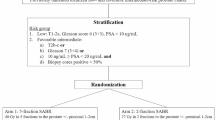Background:
High-dose-rate interstitial radiation therapy is a newly introduced modality, and its role in the management of gynecologic malignancies remains to be studied. Clinical experience in high-dose-rate interstitial radiation therapy was retrospectively investigated.
Patients and Methods:
Eight patients with primary and nine with recurrent gynecologic malignancies underwent high-dose-rate interstitial radiation therapy with/without external-beam irradiation. Fractional dose of the high-dose-rate interstitial radiation therapy ranged between 4 and 6 Gy with total doses of 15–54 Gy. Interstitial irradiation was performed twice daily with an interval of > 6 h.
Results:
2-year local control rate was 75% for primary treatment and 47% for treatment of recurrence (p = 0.46). Maximum tumor size had a statistically significant impact on local control (p < 0.002). Grade 2 and 4 late complications were seen in five patients, and the incidence was significantly higher in patients with a larger volume enclosed by the prescribed fractional dose of high-dose-rate interstitial radiation therapy. The incidence of grade 2 and 4 complications at 18 months was 78% and 0% with a volume > 100 cm3 and ≤ 100 cm3, respectively (p < 0.04).
Conclusion:
Although high-dose-rate interstitial radiation therapy is a promising modality, it must be applied cautiously to patients with bulky tumors because of the high incidence of serious complications.
Hintergrund:
Die interstitielle High-Dose-Rate-(HDR-)Bestrahlung ist eine neu eingeführte Modalität, deren Rolle bei der Behandlung von gynäkologischen Malignomen noch zu klären ist. Eigene klinische Erfahrungen mit der interstitiellen HDR-Bestrahlung wurden retrospektiv analysiert.
Patienten und Methodik:
Acht Patientinnen mit primären Malignomen und neun Patientinnen mit Redizidiven im gynäkologischen Bereich unterzogen sich einer interstitiellen HDR-Bestrahlung (mit/ohne perkutane Bestrahlung) mit 4–6 Gy bei einer Gesamtdosis von 15–54 Gy. Die interstitielle Bestrahlung wurde zweimal täglich im Abstand von > 6 h durchgeführt.
Ergebnisse:
Die lokale 2-Jahres-Kontrollrate betrug bei der Primärtherapie 75% und bei der Behandlung von Rezidiven 47% (p = 0,46). Die maximale Tumorgröße hatte einen statistisch signifikanten Einfluss auf die lokale Kontrollrate (p < 0,002). Spätkomplikationen Grad 2 und 4 fanden sich bei fünf Patientinnen, und ihre Häufigkeit war signifikant von dem brachytherapeutisch behandelten Volumen abhängig. Bei 78% der Patientinnen mit einem Volumen > 100 cm3 fanden sich nach 18 Monaten Komplikationen Grad 2 und 4, dagegen bei 0% der Patientinnen mit kleinerem Volumen (p < 0,04).
Schlussfolgerung:
Obwohl die interstitielle HDR-Bestrahlung eine viel versprechende Modalität ist, muss sie bei Patientinnen mit großen Tumoren wegen der hohen Inzidenz schwerer Komplikationen vorsichtig angewandt werden.
Similar content being viewed by others
Author information
Authors and Affiliations
Corresponding author
Rights and permissions
About this article
Cite this article
Itami, J., Hara, R., Kozuka, T. et al. Transperineal High-Dose-Rate Interstitial Radiation Therapy in the Management of Gynecologic Malignancies. Strahlenther Onkol 179, 737–741 (2003). https://doi.org/10.1007/s00066-003-1069-1
Received:
Accepted:
Issue Date:
DOI: https://doi.org/10.1007/s00066-003-1069-1



